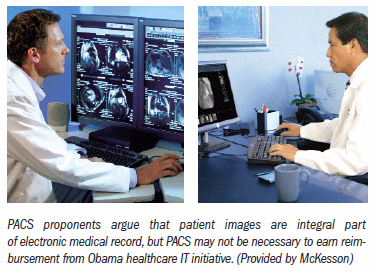PACS role remains uncertainin Obama health incentives
Like many parts of the Obama administration'sstimulus plan, the $19 billion setaside for healthcare IT contains manyuncertainties.
Like many parts of the Obama administration's stimulus plan, the $19 billion set aside for healthcare IT contains many uncertainties. Among them is where PACS fits-if it fits anywhere at all.

“As the bill is written and interpreted today, we don't believe that PACS are necessary to get the stimulus money,” said Mikael Ohman, senior vice president of McKesson strategy and business development. “But it is a bit unclear. You could make the argument that a medical image is an integral part of the medical record.”
McKesson Technology Solutions in February launched Achieve HIT, a program designed to answer questions about government incentives built into the American Recovery and Reinvestment Act. The program also seeks to acquaint doctors and healthcare administrators with its portfolio of HIT products and services.
The company has set up an online information resource for physicians (www.mckesson.com/doctors) and hotline (1-877-EHR-1MCK) to talk with McKesson representatives about their electronic health record (EHR) re-quirements. Hot links on the website take the visitor to a description of the company's equipment and services that company executives believe will allow providers to access reimbursement money under the bill. Less is known, however, than McKesson would like.
Only the broad outlines of the government's plan are yet understood, Ohman said. A key point is that the initiative does not reimburse providers for buying HIT equipment. Instead, it reimburses for “meaningful use” of HIT, a term that as yet has no clear definition.
“The term ‘meaningful use' will have to be defined over the next six to nine months by the leadership of Health and Human Services and the Office of National Coordinator for Health Information Technology,” Ohman said.
Also needing definition is a “certified” product.
“It is unclear what certification will involve,” he said. “There is speculation that the Certification Commission for Healthcare Information Technology will be the standard, but there is no guarantee.”
The government doesn't have much time to work out the details. The Obama incentives are scheduled to take effect October 2010 for hospitals and January 2011 for physicians. They offer reimbursements up to $64,000 for physicians and between $2 million and $8 million for hospitals. These incentives could accelerate the adoption of healthcare IT, particularly among physicians, the great majority of whom still rely on paper to practice medicine.
“But because the funding is tied to the use of HIT and because it takes quite a while for some of these systems to reach their potential from the time a purchase decision is made, they have to start thinking about this right now,” Ohman said.
Given the uncertainties of the Obama stimulus plan, Ohman suggests that providers look to an end goal of improving the efficiency of healthcare rather than reaping the potential monetary rewards of the Obama plan. McKesson wants to lend a hand through its Achieve HIT while the company works with competitors to get a better handle on the intricacies of the Obama plan.
Together the industry is trying to help shape policy.
“[Policy] that will be beneficial to our collective customers and businesses,” he said. “Then we turn around and compete vigorously for contracts, which I think is a very healthy way of doing things.”
The Reading Room: Artificial Intelligence: What RSNA 2020 Offered, and What 2021 Could Bring
December 5th 2020Nina Kottler, M.D., chief medical officer of AI at Radiology Partners, discusses, during RSNA 2020, what new developments the annual meeting provided about these technologies, sessions to access, and what to expect in the coming year.
Strategies to Reduce Disparities in Interventional Radiology Care
March 19th 2025In order to help address the geographic, racial, and socioeconomic barriers that limit patient access to interventional radiology (IR) care, these authors recommend a variety of measures ranging from increased patient and physician awareness of IR to mobile IR clinics and improved understanding of social determinants of health.